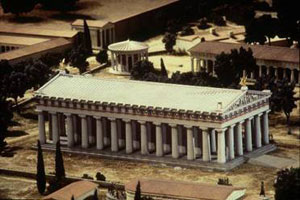|
Cultural achievements of the ancient Olympics
[ 2007-06-28 14:24 ]
古代奥运会不仅仅是运动员们竞技的舞台,它也为古希腊人创造举世闻名的文化成就提供了契机。许多现在看来珍贵的艺术品和文化遗产都与古代奥运会有着密切的联系。
 The Olympic festival not only celebrated excellence in athletics. It also provided the occasion for Greeks to produce lasting cultural achievements in architecture, mathematics, sculpture, and poetry. The Olympic festival not only celebrated excellence in athletics. It also provided the occasion for Greeks to produce lasting cultural achievements in architecture, mathematics, sculpture, and poetry.
The ancient Greeks were architectural innovators. The temple of Zeus, designed by the architect Libon, was one of the largest Doric temples built in Greece. Libon tried to build the temple in an ideal system of proportions, so that the distance between the columns was harmoniously proportional to their height, and the other architectural elements were sized proportionately as well. The Greek mathematician Euclid expressed this ideal ratio in his Elements, a book on geometry which is said to be the second most popular book of all time, after the Bible.
Greek sculptors developed new poses showing energetic movement, and depicting the muscles and shapes of the body naturally. Many sculptures were of athletes, such as Myron's famous statue of the Discus Thrower (Diskobolos).
The cultural achievement most directly tied to the Olympic games was poetry commissioned in honor of athletic victors. These poems, called Epinicians, were written by the most famous poets of the day, including Pindar, Bacchylides, and Simonides, and they were extremely popular. Proof of this is that the playwright Aristophanes portrays an average, not especially literary Athenian man who asks his son to sing a particular forty-year-old epinician poem composed by Simonides. The poem, and the athlete, live on in people's memories long after the day of victory. The epinician odes were written to immortalize the athletic victors, and they have lasted longer than many of the statues and inscriptions which were made for the same purpose.
(通讯员孙伟 王乐迪投稿 英语点津boeybb编辑)
点击查看更多奥运百科
|